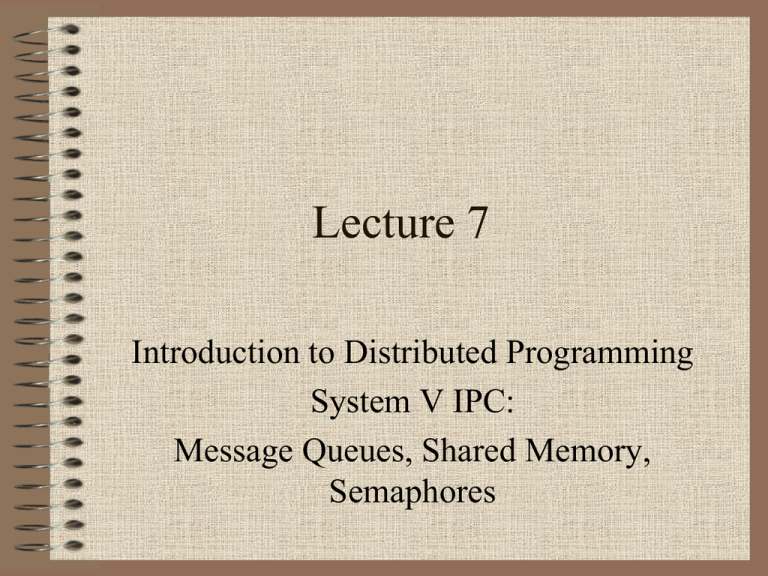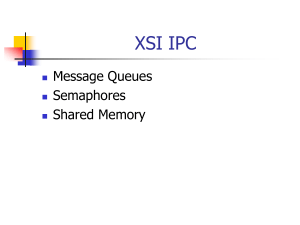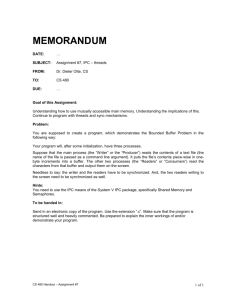Lecture 7
advertisement

Lecture 7
Introduction to Distributed Programming
System V IPC:
Message Queues, Shared Memory,
Semaphores
Introduction to Distributed
Programming
Definitions
• “Distributed programming is the spreading of a
computational task across several programs, processes or
processors.” – Chris Brown, Unix Distributed
Programming
• “A distributed system is one in which the failure of a
computer you didn’t even know existed can render your
own computer unusable.” – Leslie Lamport
• “A parallel computer is a set of processors that are able to
work cooperatively to solve a computational problem.” –
Ian Foster, Designing and Building Parallel Programs
• “A distributed system is a system in which multiple
processes coordinate in solving a problem and, in the
process of solving that problem, create other problems.” –
Mark Shacklette
Benefits of Distributed
Programming
• Divide and Conquer
– Concurrency
– Parallelism
• Component Reuse via pipelines (Modularity)
• Location Independence
• Scalability
• Resource Sharing
Problem Space
• Problem 1
– You have 1 hour to peel 1000 potatoes
– You have 10 people available
• Problem 2
– You have 1 hour to do the dishes after a dinner for
1000 guests
– You have 10 people available
• Problem 3
– You have 1 hour to lay the brick around a 5’ square
dog house
– You have 10 people available
Facilitating Division of Labor:
Work and Communication
• Single Machine Inter-process Communication
– (Signals)
– Pipes (named and unnamed)
– System V and POSIX IPC
• Multiple Machine Inter-process Communication
– Sockets
– Remote Procedure Calls (Sun ONC, OSF DCE, Xerox
Courier (4.3BSD))
– Distributed Shared Memory (Berkeley mmap)
• Single Machine Division of Labor:
– Processes
– Threads
Methods of Solution Distribution:
Input Distribution (Division of Labor)
• Workload Decomposition
– Potato Peelers aboard the USS Enterprise
• loosely coupled (little coordination)
– Roofers or Bricklayers
• tightly coupled (high coordination)
• Software: large database query of all records with a given
characteristic
– Strategy: Divide and Conquer
– Key: Exact same code is operating on different sets of input data
• Software: large matrix multiplication
– Strategy: Divide and Conquer
– Key: Exact same code is operating on different parts of the
matrices
Methods of Solution Distribution:
Process Decomposition (Inter-process
Communication)
• Divide not the work, but the process of conducting the work
– Factory Production Line:
• Identical widgets are coming along the converyor belt, but
several things have to be done to each widget
– Dish Washing Example
• collector, washer, dryer, cabinet deployer
• multiple washers and dryers can be employed (using Input
Distribution)
• Software: A Trade Clearing System
– Each trade must be entered, validated, reported, notified
– Each task can run within a different process on a different
processor
– Strategy: divide the work to be done for each trade into separate
processes, thus increasing overall system throughput
Problems in Distributed
Solutions
• Data access must be synchronized among
multiple processes
• Multiple processes must be able to communicate
among themselves in order to coordinate
activities
• Multiple coordinating processes must be able to
locate one another
Interprocess Communication and
Synchronization using
System V IPC
Message Queues
Shared Memory
Semaphores
System V IPC
• System V IPC was first introduced in SVR2, but
is available now in most versions of unix
• Message Queues represent linked lists of
messages, which can be written to and read from
• Shared memory allows two or more processes to
share a region of memory, so that they may each
read from and write to that memory region
• Semaphores synchronize access to shared
resources by providing synchronized access
among multiple processes trying to access those
critical resources.
Message Queues
• A Message Queue is a linked list of message
structures stored inside the kernel’s memory
space and accessible by multiple processes
• Synchronization is provided automatically by the
kernel
• New messages are added at the end of the queue
• Each message structure has a long message type
• Messages may be obtained from the queue either
in a FIFO manner (default) or by requesting a
specific type of message (based on message type)
Message Structs
• Each message structure must start with a
long message type:
struct mymsg {
long msg_type;
char mytext[512]; /* rest of message */
int somethingelse;
float dollarval;
};
Message Queue Limits
• Each message queue is limited in terms of both
the maximum number of messages it can contain
and the maximum number of bytes it may contain
• New messages cannot be added if either limit is
hit (new writes will normally block)
• On linux, these limits are defined as (in
/usr/include/linux/msg.h):
– MSGMAX
– MSBMNB
8192 /*total number of messages */
16384 /* max bytes in a queue */
Obtaining a Message Queue
•
•
•
•
•
#include <sys/types.h>
#include <sys/ipc.h>
#include <sys/msg.h>
int msgget(key_t key, int msgflg);
key is either a number or the constant IPC_PRIVATE (parent/child)
a msgid is returned
key_t ftok(const char * path, int id) will return a key value for IPC
usage
The key parameter is either a non-zero identifier for the queue to be
created or the value IPC_PRIVATE, which guarantees that a new
queue is created.
The msgflg parameter is the read-write permissions for the queue
OR’d with one of two flags:
– IPC_CREAT will create a new queue or return an existing one
– IPC_EXCL added will force the creation of a new queue, or
return an error
Writing to a Message Queue
int msgsnd(int msqid, const void * msg_ptr,
size_t msg_size, int msgflags);
•
•
•
•
msgqid is the id returned from the msgget call
msg_ptr is a pointer to the message structure
msg_size is the size of that structure
msgflags defines what happens when the queue is
full, and can be set to the following:
– IPC_NOWAIT (non-blocking, return –1 immediately
if queue is full)
Reading from a Message Queue
int msgrcv(int msqid, const void * msg_ptr, size_t msg_size, long
msgtype, int msgflags);
•
•
•
•
msgqid is the id returned from the msgget call
msg_ptr is a pointer to the message structure
msg_size is the size of that structure
msgtype is set to:
= 0 first message available in FIFO stack
> 0 first message on queue whose type equals type
< 0 first message on queue whose type is the lowest value
less than or equal to the absolute value of msgtype
• msgflags defines what happens when no message of the appropriate
type is waiting, and can be set to the following:
– IPC_NOWAIT (non-blocking, return –1 immediately if queue is
empty)
• example: ~mark/pub/51081/message.queues/potato.*.c
Message Queue Control
struct msqid_ds {
...
/* pointers to first and last messages on queue */
__time_t msg_stime;
/* time of last msgsnd command */
__time_t msg_rtime;
/* time of last msgrcv command */
...
unsigned short int __msg_cbytes;
/* current number of bytes on queue */
msgqnum_t msg_qnum;
/* number of messages currently on queue */
msglen_t msg_qbytes;
/* max number of bytes allowed on queue */
...
/* pids of last msgsnd() and msgrcv() */
};
• int msgctl(int msqid, int cmd, struct msqid_ds * buf);
• cmd can be one of:
– IPC_RMID
destroy the queue specified by msqid
– IPC_SET
set the uid, gid, mode, and qbytes for the
queue, if adequate permission is available
– IPC_STAT
get the current msqid_ds struct for the queue
• example: query.c
Shared Memory
• Normally, the Unix kernel prohibits one process
from accessing (reading, writing) memory
belonging to another process
• Sometimes, however, this restriction is
inconvenient
• At such times, System V IPC Shared Memory
can be created to specifically allow one process
to read and/or write to memory created by
another process
Advantages of Shared Memory
• Random Access
– you can update a small piece in the middle of a
data structure, rather than the entire structure
• Efficiency
– unlike message queues and pipes, which copy
data from the process into memory within the
kernel, shared memory is directly accessed
– Shared memory resides in the user process
memory, and is then shared among other
processes
Disadvantages of Shared Memory
• No automatic synchronization as in pipes or
message queues (you have to provide any
synchronization). Synchronize with semaphores
or signals.
• You must remember that pointers are only valid
within a given process. Thus, pointer offsets
cannot be assumed to be valid across interprocess boundaries. This complicates the sharing
of linked lists or binary trees.
Creating Shared Memory
int shmget(key_t key, size_t size, int shmflg);
• key is either a number or the constant
IPC_PRIVATE (man ftok)
• a shmid is returned
• key_t ftok(const char * path, int id) will return a
key value for IPC usage
• size is the size of the shared memory data
• shmflg is a rights mask (0666) OR’d with one of
the following:
– IPC_CREAT
– IPC_EXCL
will create or attach
creates new or it will error
if it exists
Attaching to Shared Memory
• After obtaining a shmid from shmget(), you need
to attach or map the shared memory segment to
your data reference:
void * shmat(int shmid, void * shmaddr, int shmflg)
• shmid is the id returned from shmget()
• shmaddr is the shared memory segment address.
Set this to NULL and let the system handle it.
• shmflg is one of the following (usually 0):
– SHM_RDONLY
sets the segment readonly
– SHM_RND
sets page boundary access
– SHM_SHARE_MMU set first available aligned
address
Shared Memory Control
struct shmid_ds {
int shm_segsz;
__time_t shm_atime;
__time_t shm_dtime;
...
unsigned short int __shm_npages;
msgqnum_t shm_nattach;
...
};
/* size of segment in bytes */
/* time of last shmat command */
/* time of last shmdt command */
/* size of segment in pages */
/* number of current attaches */
/* pids of creator and last shmop */
• int shmctl(int shmid, int cmd, struct shmid_ds * buf);
• cmd can be one of:
– IPC_RMID
– IPC_SET
– IPC_STAT
destroy the memory specified by shmid
set the uid, gid, and mode of the shared mem
get the current shmid_ds struct for the queue
• example: ~mark/pub/51081/shared.memory/linux/*
Matrix Multiplication
• Multiply two n x n matrices, a and b
• One each iteration, a row of A multiplies a
column of b, such that:
Semaphores
• Shared memory is not access controlled by the
kernel
• This means critical sections must be protected
from potential conflicts with multiple writers
• A critical section is a section of code that would
prove problematic if two or more separate
processes wrote to it simultaneously
• Semaphores were invented to provide such
locking protection on shared memory segments
System V Semaphores
• You can create an array of semaphores that can be
controlled as a group
• Semaphores (Dijkstra, 1965) may be binary (0/1), or
counting
1 == unlocked (available resource)
0 == locked
• Thus:
– To unlock a semaphore, you +INCREMENT it
– To lock a semaphore, you -DECREMENT it
• Spinlocks are busy waiting semaphores that constantly
poll to see if they may proceed (Dekker’s Algorithm)
How Semaphores Work
• A critical section is defined
• A semaphore is created to protect it
• The first process into the critical section locks the critical
section
• All subsequent processes wait on the semaphore, and they
are added to the semaphore’s “waiting list”
• When the first process is out of the critical section, it
signals the semaphore that it is done
• The semaphore then wakes up one of its waiting
processes to proceed into the critical section
• All waiting and signaling are done atomically
How Semaphores “Don’t” Work:
Deadlocks and Starvation
• When two processes (p,q) are both waiting on a
semaphore, and p cannot proceed until q signals, and q
cannot continue until p signals. They are both asleep,
waiting. Neither can signal the other, wake the other up.
This is called a deadlock.
– P1 locks a which succeeds, then waits on b
– P2 locks b which succeeds, then waits on a
• Indefinite blocking, or starvation, occurs when one
process is constantly in a wait state, and is never signaled.
This often occurs in LIFO situations.
• example:
~mark/pub/51081/semaphores/linux/shmem.matrix.multip
lier2.c






